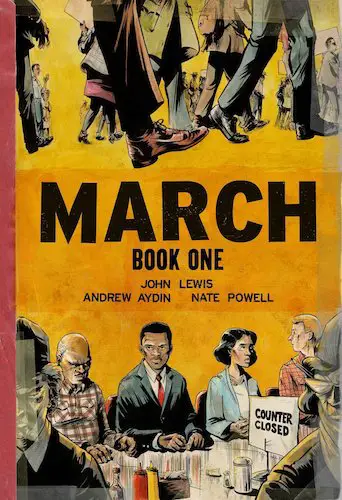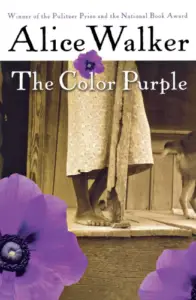March: Book One
Book Author: Andrew Aydin and John Lewis
Summary reviewed by:
Terrence Timmons
Terrence Timmons
Analyst
Bachelor of Arts (BA), University Of California, Santa Barbara 2019
With over 4 years of experience as an analyst. Terrence Timmons is committed to analyzing summaries without compromising on quality.
March: Book One: Summary
In a world crying out for justice, "March: Book One" emerges as a beacon of hope, illuminating the path walked by those who dared to confront segregation and inequality. Crafted by the legendary civil rights leader John Lewis, along with co-author Andrew Aydin and illustrator Nate Powell, this graphic novel transports readers to the heart of the American civil rights movement, through the eyes of Lewis himself. From the humble beginnings on a southern farm to the historic steps of the Edmund Pettus Bridge, Lewis's journey is not just a tale of personal growth but a testament to the collective power of nonviolent protest in the quest for human rights.
At its core, the narrative bridges the personal with the political, offering a first-hand account of the pivotal moments that defined the movement. It begins with Lewis's early life in Alabama, where he developed a deep connection with the Baptist church and a burgeoning commitment to justice. As we follow his footsteps to Nashville, where he joins the student sit-in movement, the novel adeptly captures the spirit of youth-led activism and the relentless fight against segregation at lunch counters.
"March: Book One" is not merely a recounting of historical events; it is a vivid, emotional journey marked by moments of both triumph and tragedy. It challenges readers to consider the moral courage required to stand up against systemic injustice and the resilience needed to sustain a long-term struggle for change. Through Powell's striking black-and-white illustrations, the narrative's intensity is palpable, bringing to life the speeches, protests, and confrontations with a raw honesty.
What makes this book especially compelling is its relevance to contemporary struggles for justice and equality. As Lewis reflects on his experiences, he also offers wisdom for today's activists, drawing a throughline from the past to the present and underscoring the ongoing nature of the fight for civil rights.
In essence, "March: Book One" is a call to action—a reminder that history is not just about the past, but a guidepost for the future. It's an invitation to march alongside John Lewis, not just through the pages of a graphic novel, but in the continued pursuit of a more just and equitable world.
March: Book One: Genres
Non-fiction
Graphic Novel
Memoir
Historical Nonfiction
Political / Social Activism
Autobiography
African American Literature
Social Justice
March: Book One: Main Characters
John Lewis: A beacon of hope and resilience, Lewis’s deep-rooted values of nonviolence and justice are evident in his leadership of the student sit-in movement, showcasing his commitment to peaceful protest and equal rights for all.
Jim Lawson: A pivotal mentor to Lewis, Lawson embodies wisdom and strategic nonviolence, instrumental in shaping the young activists’ approach to civil disobedience, emphasizing the power of love and peaceful resistance in combating systemic racism.
Diane Nash: A strong, strategic leader within the Nashville Student Movement, Nash’s determination and unwavering commitment to justice are clear when she leads the charge to continue sit-ins, demonstrating the strength of women in the civil rights movement.
Martin Luther King Jr.: Though not a main character in the traditional sense, his influence looms large over the narrative, representing the moral and spiritual guidance that fueled the civil rights movement, inspiring Lewis and others to take up the mantle of nonviolent protest.
March: Book One: Themes
Nonviolent Protest: Central to the book, this theme is illustrated through the sit-ins and peaceful demonstrations, showcasing the strategic use of nonviolence as a powerful tool against systemic oppression.
Youth Activism: The involvement of young people in the civil rights movement, particularly through the student sit-ins, highlights the significant impact of youth leadership and activism in societal change.
Racial Equality: The fight against segregation at lunch counters and in public spaces underpins the broader struggle for racial equality, emphasizing the dignity and rights of African Americans.
Moral Courage: The personal risks taken by activists, facing violence and arrest, exemplify the moral courage required to challenge unjust laws and societal norms, showcasing the inner strength of those committed to justice.
Community and Solidarity: The collective action of the Nashville Student Movement, alongside mentors and fellow activists, illustrates the importance of community and solidarity in the fight against systemic racism, showing how united efforts can lead to significant social change.
March: Book One: Methodology
In writing this book summary of "March: Book One," our approach was anchored in a deep respect for your intellectual curiosity and a commitment to integrity. With meticulous expert analysis, we delved into the heart of John Lewis's narrative, extracting the essence of his journey towards justice and the powerful lessons it imparts. By synthesizing content, we distilled pivotal moments and key themes, such as the potency of nonviolent protest and the vital role of youth activism, into a concise, engaging narrative. Our aim? To not only illuminate Lewis's legacy but also to empower you with knowledge that resonates and inspires action in the quest for equality and rights.


March: Book One
Date Published: August 13, 2013
Disclaimer: As an Amazon Associate I earn from qualifying purchases.




